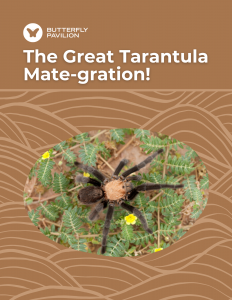The Great Tarantula Mate-gration!
3rd-6th Grade
Cost: $5
Embark on an engaging educational “migration” with your students by transporting your classroom to the grasslands of Southeastern Colorado. Many believe male tarantulas migrate in large numbers in Southern Colorado each fall, but they’re actually searching for mates. In this lesson, your students will observe the Oklahoma Brown tarantula “mate-gration” and explore tarantula anatomy, behavior, habitats, and conservation efforts. Your students will learn that there’s much more to tarantulas than meets the (panicked) eye. Ignite curiosity and deepen your students’ understanding of invertebrates as they connect with the natural world from the comfort of your classroom.

Redistribution Policy:
Nothing in this lesson plan may be copied or reproduced without written permission from Butterfly Pavilion, except for student worksheets, which may be reproduced for educational use in connection with the activities provided.
Tax Exemption
If you are purchasing with a tax-exempt card, please reach out to education@butterflies.org so that we can exclude tax from your purchase.
Questions?
For questions about our downloadable lesson plans, email us at education@butterflies.org. Email is the best way to reach the Registrar.
If you prefer to speak by phone, call us at 720-974-1861.
Next Generation Science Standards Supported:
- 3-LS4-2 Use evidence to construct an explanation for how the variations in characteristics among individuals of the same species may provide advantages in surviving, finding mates, and reproducing.
- 3-LS4-3 Construct an argument with evidence that in a particular habitat some organisms can survive well, some survive less well, and some cannot survive at all.
- 4-LS1-1 Construct an argument that plants and animals have internal and external structures that function to support survival, growth, behavior, and reproduction.
- 4-LS1-2 Use a model to describe that animals receive different types of information through their senses, process the information in their brain, and respond to the information in different ways.
- 5-ESS3-1 Obtain and combine information about ways individual communities use science ideas to protect the Earth’s resources and environment.
- MS-LS2-1 Analyze and interpret data to provide evidence for the effects of resource availability on organisms and populations of organisms in an ecosystem.
- MS-LS2-4 Construct an argument supported by empirical evidence that changes to physical or biological components of an ecosystem affect populations.
- MS-LS2-5 Evaluate competing design solutions for maintaining biodiversity and ecosystem services.
- MS-ESS3-3 Apply scientific principles to design a method for monitoring and minimizing a human impact on the environment.


